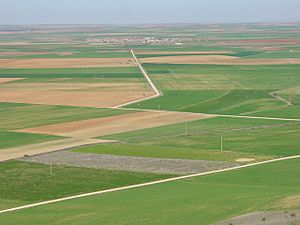Meseta Central facts for kids
The Meseta Central (which means "central tableland" or "Inner Plateau") is a huge, flat area in the middle of the Iberian Peninsula. It's like a giant, high table that covers a big part of Spain's inside. This plateau is one of the most important landforms in the region.
Contents
What is the Meseta Central?
The Meseta Central is a large plateau, which is a high, flat area of land. It's located in the heart of Spain. Think of it as a huge, elevated plain. This area is very important for understanding the geography of the Iberian Peninsula.
How the Name Became Popular
The idea of the "Meseta Central" became well-known in the 1800s. A scientist named Heinrich Moritz Willkomm first used the term. Later, Salvador Calderón y Arana was one of the first to write it with capital letters, making it a proper place name. Writers from a group called the "Generation of '98" also helped make the name popular with everyone.
Parts of the Meseta Central
A major mountain range called the Sistema Central cuts right through the Meseta Central. This divides the plateau into two main parts:
- Submeseta Norte: This is the northern part. It's generally higher, with most areas being about 700 to 800 meters (2,300 to 2,600 feet) above sea level. The Douro River flows through and drains this northern section.
- Submeseta Sur: This is the southern part. It's a bit lower, usually between 600 to 700 meters (2,000 to 2,300 feet) high. Two important rivers, the Tagus and the Guadiana, flow through and drain this southern section.
Mountains Around the Meseta
The Meseta Central is surrounded by several mountain ranges that act like natural borders. These include:
- The Montes de León
- The Galician Massif
- The Cantabrian Range
- The Basque Mountains
- The Sistema Ibérico
- And Sierra Morena
These mountains help define the edges of this vast central plateau.
See also
 In Spanish: Meseta Central para niños
In Spanish: Meseta Central para niños



